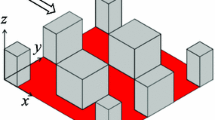Abstract
In the atmospheric boundary layer (ABL), under high pressure conditions and negligible geostrophic winds, problems associated with pollution are the most critical. In this situation, the urban heat island plays a major role in the close-to-the-ground atmospheric dynamics and in dispersion processes at scales in the order of tens of meters (small scales). This article presents water tank laboratory simulations of an urban heat island in a stably stratified ABL, neglecting geostrophic winds and the effects of Coriolis force. The phenomenon is studied in the framework of a similarity theory developed for a nocturnal and low-aspect ratio urban heat island extended to the diurnal case. Image analysis techniques appear suitable to fully describe the phenomenon. The high resolution data provides a detailed fluid dynamic characterization of the urban heat island circulation. Present laboratory results, normalized by similarity theory scaling parameters, compare well with literature data.
Graphical Abstract








Similar content being viewed by others
References
Catalano F, Cenedese A, Falasca S, Moroni M (2012) Numerical and experimental simulations of local winds. In: Fernando HJS, Klaic ZB, McCulley JL (eds) National security and human health implications of climate change. Springer, Berlin, pp 199–218
Cenedese A, Monti P (2003) Interaction between an Inland urban heat island and a sea breeze flow: a laboratory study. J Appl Meteorol 42:1569–1583
Clarke JF, McElroy JL (1974) Effects of ambient meteorology and urban morphological features on the vertical temperature structure over cities. In: Proceedings of the 67th annual meeting of air pollution control association, Denver, CO, USA
Faust KM (1981) Modelldarstellung von Wärmeinselströmungen durch konvektionsstrahlen. PhD dissertation (SFB 80/ET/201) Universität Karlsruhe, Karlsruhe, pp 144
Godowitch JM, Ching JKS, Clarke JF (1987) Spatial variation of the evolution and structure of the urban boundary layer. Bound Layer Meteorol 38:249–272
Hidalgo J, Masson V, Gimeno L (2010) Scaling the daytime urban heat island and urban-breeze circulation. J Appl Meteorol Climatol 49:889–901
Kozmar H (2010) Scale effects in wind tunnel modeling of an urban atmospheric boundary layer. Theor Appl Climatol 100:153–162
Kristof G, Rácz N, Balogh M (2009) Adaptation of pressure based CFD solvers for mesoscale atmospheric problems. Bound Layer Meteorol 131:85–103
Kurbatskii AF (2001) Computational modeling of the turbulent penetrative convection above the urban heat island in a stably stratified environment. J Appl Meteorol 40:1748–1761
Lu J, Arya SP, Snyder WH, Lawson RE Jr (1997a) A laboratory study if the urban heat island in a calm and stably stratified environment. Part I: temperature field. J Appl Meteorol 36:1377–1391
Lu J, Arya SP, Snyder WH, Lawson RE Jr (1997b) A laboratory study if the urban heat island in a calm and stably stratified environment. Part II: velocity field. J Appl Meteorol 36:1392–1402
Meroney RN, Melbourne WH (1992) Operating ranges of meteorological wind tunnels for the simulation of convective boundary layer (CBL) phenomena. Bound Layer Meteorol 61:145–174
Moroni M, Cenedese A (2005) Comparison among feature tracking and more consolidated velocimetry analysis techniques in a fully developed channel flow. Meas Sci Technol 16:2307–2322
Richiardone R, Brusasca G (1989) Numerical experiments on urban heat island intensity. Quart J Roy Met Soc 115:983–995
Snyder WH (1981) Guideline for fluid modeling of atmospheric diffusion. EPA technical report. EPA -600/8-81-009
Varshney K, Poddar K (2011) Experiments on integral length scale control in atmospheric boundary layer wind tunnel. Theor Appl Climatol 106:127–137
Varshney K, Poddar K (2012) Prediction of wind properties in urban environments using artificial neural network. Theor Appl Climatol 107:579–590
Yoshikado H (1992) Numerical study of the daytime urban effect and its interaction with the sea breeze. J Appl Meteorol 31:1146–1164
Yuan R, Wu X, Luo T, Liu H, Sun J (2011) A review of water tank modeling of the convective atmospheric boundary layer. J Wind Eng Ind Aerodyn 99:1099–1114
Acknowledgments
We thank Arianna Ferrari and Marco Giorgilli for their assistance in taking the laboratory measurements.
Author information
Authors and Affiliations
Corresponding author
Rights and permissions
About this article
Cite this article
Falasca, S., Moroni, M. & Cenedese, A. Laboratory simulations of an urban heat island in a stratified atmospheric boundary layer. J Vis 16, 39–45 (2013). https://doi.org/10.1007/s12650-012-0150-1
Received:
Revised:
Accepted:
Published:
Issue Date:
DOI: https://doi.org/10.1007/s12650-012-0150-1




